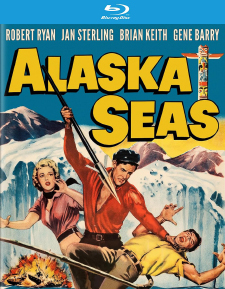Alaska Seas (Blu-ray Review)

Director
Jerry HopperRelease Date(s)
1954 (February 13, 2024)Studio(s)
Paramount Pictures (Kino Lorber Studio Classics)- Film/Program Grade: B+
- Video Grade: A-
- Audio Grade: A-
- Extras Grade: B-
Review
For a film as tritely-written as Alaska Seas (1954), it’s more entertaining than it has any right to be. It’s a remake of Paramount’s earlier Spawn of the North (1938), a film I’ve not seen, but by the looks of it, Alaska Seas seems to incorporates much stock footage from that original film.
It’s an odd film, featuring major actors slumming through a bad script. At a time when Paramount was shooting its A-movies in Technicolor and VistaVision, this is in black-and-white, though originally exhibited in 1.66:1 widescreen. It probably cost around $700,000 to make, a modest budget for the time; it’s rife with stock footage of salmon fisherman in (presumably) Alaska, with the bulk of the film shot with a heavy reliance on (rear-projection) process shots and fishing boats in studio tanks on the backlot and/or one of Paramount’s larger soundstages.
Set in 1920s Alaska, a prologue notes the decline in the salmon population. Government interventions have forced local fisherman into a strict co-operative arrangement, led by strapping Jim Kimmerly (Brian Keith), which must fend off gangs of pirates anxious to steal the precious, hard-to-come-by salmon. As the film opens, Jim’s longtime fisherman pal Matt Kelly (top-billed Robert Ryan) is released from jail and, unable to pay Wycroff (Timothy Carey!) long-overdue docking fees, steals his own boat back. Reuniting with Jim and his fiancée, Nicki (Jan Sterling), who Matt openly wants for himself, Jim invites Matt into the co-op, despite objections from other fishermen (played by, among others, Ross Bagdasarian, Sr., Peter Coe, Richard Shannon, Gene Roth), they all too aware of Matt’s bad ne’er-do-well reputation. Inevitably, Matt falls in with the pirates, led by Verne Williams (Gene Barry).
This is one of those wearisome plots where the blind, noble hero constantly covers for the irresponsible actions of his best friend, a friend completely undeserving of such loyalty. Matt unapologetically does everything imaginable to screw his friend over: he borrows $50 from him to pay off debts which Matt immediately uses to buy a diamond ring to woo Jim’s fiancée instead. He recklessly causes a glacier avalanche that sinks Jim’s boat, yet Jim doesn’t even seem annoyed by this. This kind of storytelling tends to drive audiences nuts—Why is Jim so stupid? How can Matt be so casually destructive toward someone constantly covering for his bad judgment?
Van Heflin was originally cast as Jim but bowed out with some justification: Shane, released the previous spring, had been a humongous hit for Paramount. Why should he bother with such a mediocre film as Alaska Seas? Brian Keith, the untried son of character actor Robert Keith, makes his screen debut, though as a child he had a tiny, unbilled part in a 1924 silent film. Perhaps he was cast because he physically resembled Heflin (short, stocky, with wavy light-colored hair)? Was footage (perhaps second-unit) already in the can with Heflin or his double?
The video transfer is mostly excellent, but some scenes have the washed-out look of a Technicolor film printed in black-and-white. Did Alaska Seas start out as something more ambitious (Ryan and Sterling were major stars, and Gene Barry was coming off another huge hit for Paramount, The War of the Worlds), but then relegated to something lesser on Paramount’s schedule, merely to fill out the calendar?
Regardless, the film does deliver the goods in its action scenes and special effects. The original film received an honorary Academy Awards for its special effects; were most of these shots reused for Alaska Seas? There are many impressive matte shots of the 1920s Alaskan port towns, mattes combining real and miniature boats, and several startling shots that seem to be real fishing boats with sailors on deck matted into matte painting/miniature combinations, impressive stuff for 1954, even if a lot of it is actually from 1938!
Adding to the enjoyment are Robert Ryan—a contender for cinema’s greatest actor—Brian Keith, and Jan Sterling, all of whom give performances way better than the film deserves. Keith, debuting in a leading role, holds his own with Ryan, no small feat.
Kino’s Blu-ray of Alaska Seas is a crisp black-and-white transfer in 1.66:1 widescreen. As noted above, most of it looks great, except for some (mostly nighttime) scenes that look washed out, which could be ineffective digital tweaking or, less likely, look that way for reasons described above. The DTS-HD Master Audio (2.0 mono) is solid. Optional English subtitles are provided, and the disc is Region “A” encoded.
(Note: Kino initially sent us a review copy with a defect I’ve never encountered after 10,000 or so DVDs, HD DVDs, and Blu-rays. The disc had a dent in it, as if someone fired a BB gun at it, or maybe an Andromeda Strain-like mini-meteorite hit it. That disc, of course, was unplayable, but Kino promptly and generously sent us a replacement disc.)
Supplements are limited to a new audio commentary track by David Del Valle and Stan Shaffer.
For such a puzzling, unambitious film with a well-worn, even annoying screenplay, Alaska Seas is nonetheless watchable, even enjoyable as a B-level potboiler with a top-drawer cast.
- Stuart Galbraith IV

